 Back to selection
Back to selection
This Is Where You Work
On the Surprisingly Influential Nature of Offices by Zachary Wigon
This is Where You Work: Braden King’s Office

“With all these devices,” Braden King says as he gestures to his iPhone, “you never have to be where you are at all.” The comment is overwhelmingly appropriate, since King’s first narrative feature, HERE, which opens on April 13th at New York’s IFC Center, is about nothing so much as having an appreciation and understanding of where one is. The moment is all the more interesting since King isn’t talking about his film at all; rather, he’s talking about his office space.
A connection, regardless, begs to be made. HERE is a formalist reinvention of the road-trip romance, a film that, as King has said, is more like a road trip than about a road trip (“about” would imply more narrative conveyance of information than King would care to put forth). The film evinces a subjectivity that is heavily influenced – perhaps even defined – by the locations through which it passes. The film’s two principal characters have professions that both require attentiveness to environment: Will (Ben Foster) is a cartographer making a series of maps of Armenia for a satellite company; Gadarine (Lubna Azabal) is a landscape photographer. As the two of them travel through the Armenian countryside, we realize that as much as anything, HERE is a film about the ways in which settings affect states of being and determine experiences; and that likewise, the ways we document those settings can be seen as metaphors for how we take inventory of our past experiences – cartography and photography are two different kinds of pneumonic time capsules.
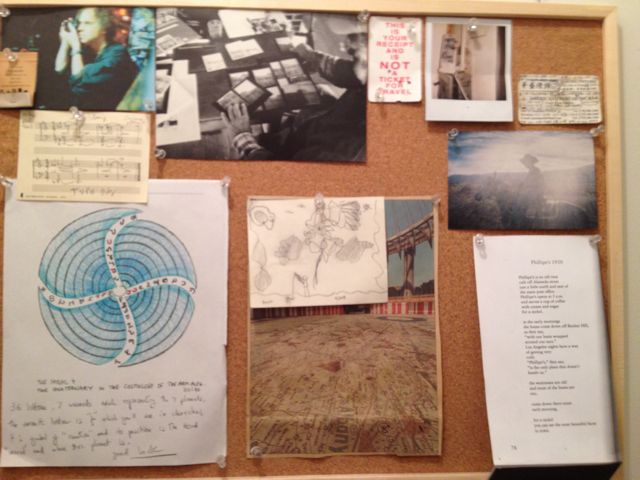
I came to view HERE from a rather unusual perspective. For the past few months, I’ve been in post-production on a short film in one of the rooms in King’s office space in the West Village. The office space itself – overflowing with paintings, photographs, notes and quotes and excerpts tacked up to the walls, images torn out of magazines and books, and all other kinds of mementos – was visually arresting. It was only after I saw HERE that I realized that the office – which has housed King for 12 years – is his own sort of cartographic or photographic canvas; the items Braden adorns his walls with are a way of charting his artistic and intellectual progressions, his passions and thoughts.
“A lot of the stuff you see on the walls here has built up over the time I’ve had this office,” King explains. “I got this space 12 years ago – I was living in a little studio apartment on Bank Street, and there was a sign on the door for an office to sublet. It has built up sedimentary layers of stuff. Why do I do this? In other places I’ve lived, as well, I’ve always put stuff up on the walls. In some ways, it’s a kind of processing – it’s like a physical version of Tumblr, where you’re grabbing little things you like and organizing, synthesizing. In another sense, whether it’s literal notes of something to do or a piece of art or a quote, they’re reminders – reminders of inspirations or feelings or moments.”
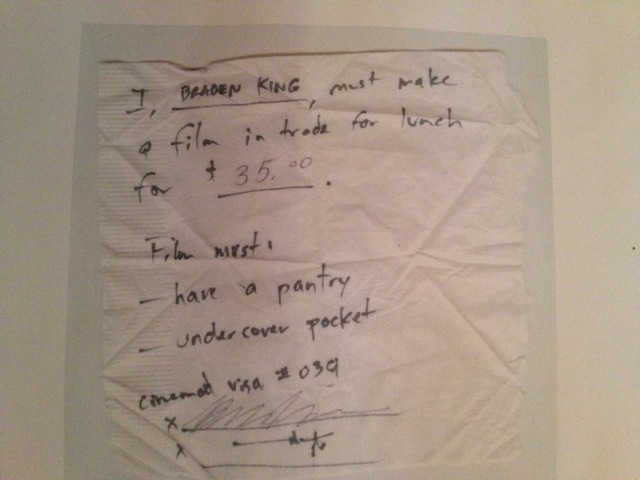
This kind of charting – using one’s workspace as a kind of physical embodiment of the map of one’s mind – is certainly nothing new in terms of the way artists decorate their offices. What is new about it is that, in an era when, as King puts it, “you never have to be where you are,” it takes on a new, outsized significance. iPhones, iPads and laptops are certainly beneficial in plenty of ways — and this is not a Luddite screed — but it’s unmistakable that prolonged engagement with such devices takes our attention out of our physical environs, into a mental space where we are powerfully stimulated. This, again, is nothing new – books have been doing it since their inception, and oral storytelling before that – but in earlier eras this kind of stimulation was the exception, not the rule of quotidian existence. Now more than ever, being aware of one’s setting requires a concerted effort.
“I put something up when it hits me really hard, but they’re also reminders,” King says. “Reminders of things that have stuck with me and of things I need to keep present. They’re ways of grounding myself in certain things. Also, it’s very easy in this day and age to spend all day in front of a screen. And when I start to feel fried I try to get up and walk around instead of clicking over to a website, another screen.”
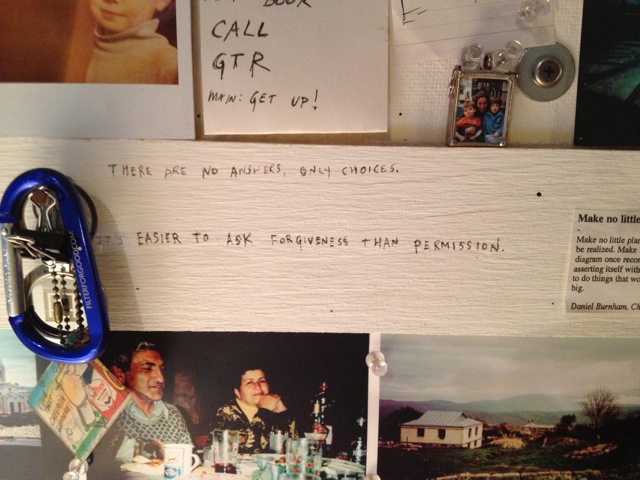
So the office serving as a kind of magnet for returning to the physical world, to the texture of spaces and the ideas that matter as opposed to the ones that don’t, seems to be the way this space operates in King’s mind. With quotes and images and effluvia floating on the walls, it begs to be noticed. He has managed to figure out how to strongly ground himself in a space, and judging by the perspective put forth in his film, that must be an important thing for him – but surely, it can’t be unimportant for any self-respecting artist.
“I’ve had this space, I’m pretty sure, longer than any house I’ve ever lived in,” King tells me. “This has been the longest constant space in my life. I often think of it as a prison I voluntarily come to every day. When I made an earlier film, Dutch Harbor, I was living in Chicago, and I ended up building the recording studio that we used for that film. Doing that kind of thing really allows you to have very productive, passive daydreaming thoughts – you think and then you go back to working with drywall. Putting all these things up on my walls is a little bit like that. There have been all these great articles in the paper recently about why people get ideas in the shower, how the distracted mind works, and that’s something that television and the computer takes away from you – it’s not passive time. So creating spaces to work in is incredibly important. I know people who love to write in cafes, which makes no sense to me. I’ve always needed my own little hole to climb into, to work.”
With that in mind, I asked King to tell me a little bit about some of the items that he found particularly important.
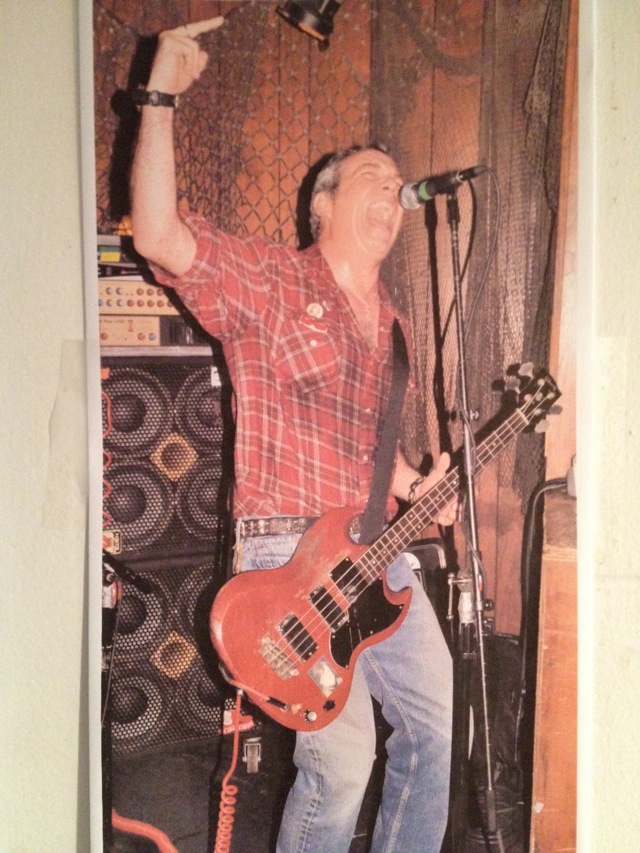
Braden King: That’s Mike Watt. Mike’s a real hero of mine, in terms of his passion and exuberance and energy and ethos. He’s someone whom I’ve known of and known a bit for quite a long time now. For anyone that knows anything about his practice as a musician, or his life in the Minutemen, or what he brings to the universe as a person, it’s an unstoppable optimism and energy. He just never stops – he’s never let anything get in his way. I’ve always been a huge fan.
Music’s played a huge role in my work – it’s been more influential than movies in a lot of ways. I spent a lot of time playing in bands, and I was a partner in a recording studio in my 20s in Chicago. The films that make me the most excited are probably closer to a musical form than a literary form – I’m more interested in tone and atmosphere and experience than I am in narrative and drama. I often think, when I’m writing, in terms of trying to create scenes or images that feel like a favorite song. I think there are many ways in which… if you have a conversation that’s concerned with the formal elements of cinema, I think it’s arguable that the talkies and specifically, narrative film, have really held back the form in terms of what it’s capable of. Cinema is a lot closer to music than what we let it do most of the time.
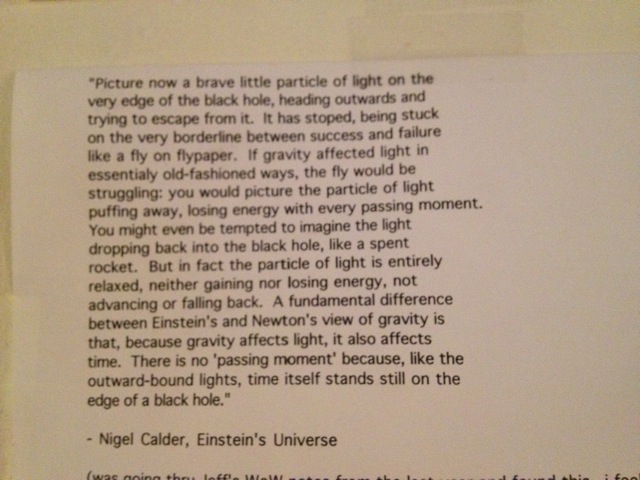
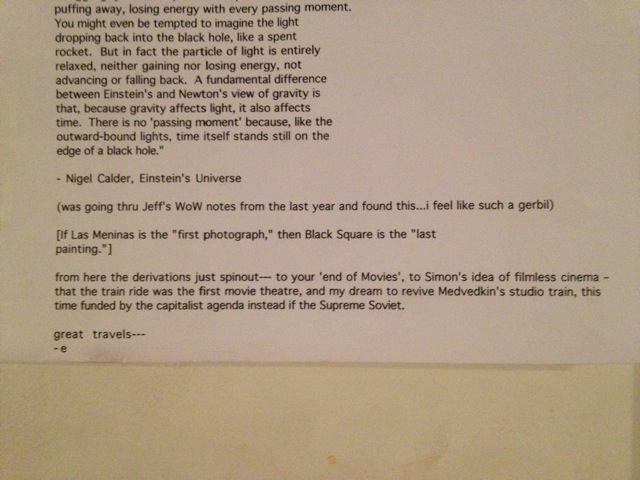
King: This is an email that was sent to me by Eve Sussman. She’s a great artist, an inspiring friend, and she did a piece called White On White, which is a noir-esque thriller set in Kazakhstan, and it’s a film that edits itself as it goes along. It re-assembles itself as you watch it. It’s never the same twice. It’s one of the greatest things that I’ve seen. So we trade emails sometimes, and this is an email she sent me about a quote she had come across. She sent this Nigel Calder quote about light and time on the edge of a black hole. I think this email was part of a conversation about what the moving image is, or could be. Something that’s been as influential to me as music is traveling – the road trip. I think the idea here is that the train ride was the first movie theater, that sitting by the window and watching the landscape go by is like watching moving images through a frame. By the way, it’s interesting that one of the first films ever made was of a train pulling into a station. I don’t think that’s totally by accident.
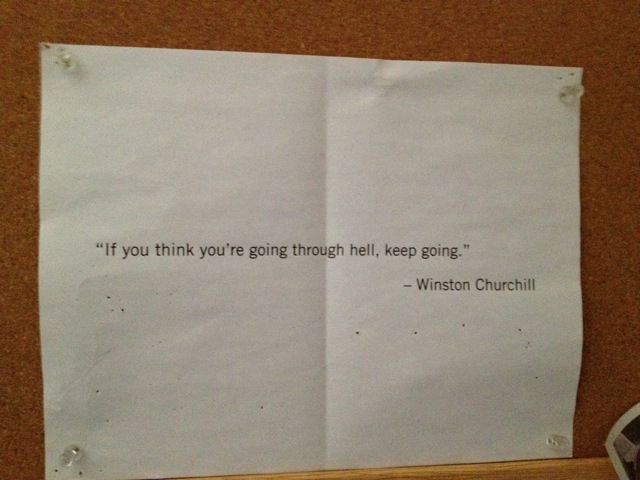
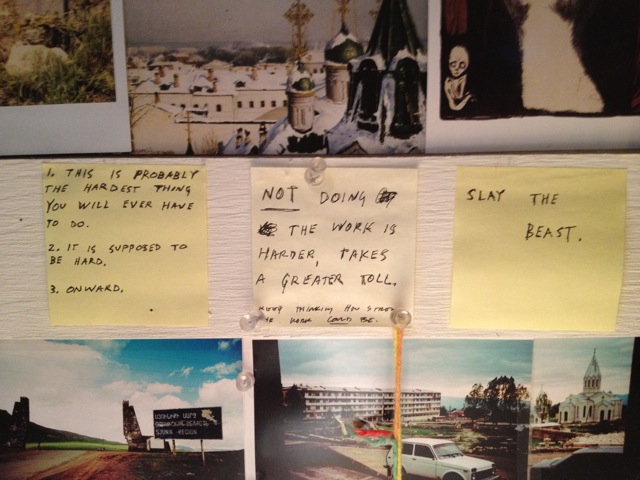
King: I feel like we all have that Hearts of Darkness moment, where it’s like, if you’re not pushing yourself past your limit, what’s the point? I’ve definitely had a romantic association with those kinds of ideas, where, if you don’t know if you can make it, you haven’t pushed it far enough yet. Hearts of Darkness, Fitzcarraldo, they all embrace those myths. Wanting to go out on a limb has always been intriguing to me. Dutch Harbor was in the Aleutian Islands, HERE was in Armenia. I’ve always been interested in taking on projects that have as much of a life experience component to them as just making the thing itself. When you put so much of your life and time in these things, and they can lead you on personal journeys at the same time, that’s a very intriguing idea. I’m very good at making things more difficult than they have to be. Not only was HERE my first narrative feature; I also made it in a country that had never had an American film produced in it before, and I created a large-scale multimedia piece to coincide with it. Passion and naïveté can get you into a lot of trouble sometimes. I really felt like, why would you do anything less than try to utilize all of yourself? Anyway, notes like these are not macho inspirations – they all come out of dealing with extreme anxiety, if not outright pain. Sometimes, even with the best of intentions, it takes a while to climb out of the holes we dig ourselves into.
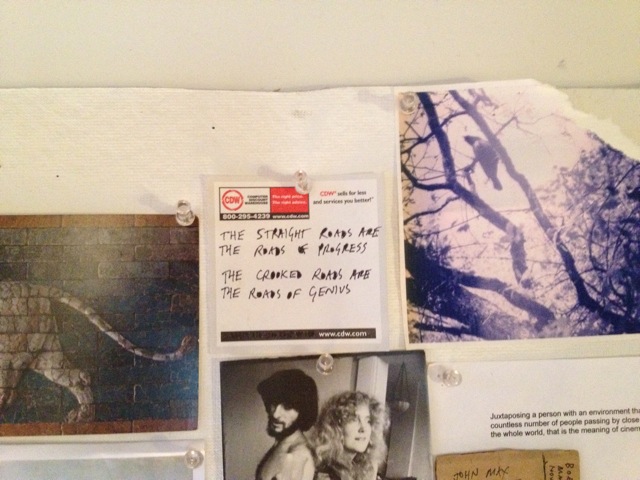
King: This note was given to me maybe 15 years ago by my composer, Mike Krassner. I think he gave that to me after I was lamenting not being productive enough.
Wigon: Ah ok. I thought it maybe had to do with the way things are received – like, a work that is received as unanimously fantastic, it makes me a bit suspicious. Whereas true works of genius are often given mixed receptions when they are first released, because they’re quite ahead of their time.
King: That’s interesting, and probably true. But in this case, it’s just about feeling better about procrastination! It’s surrounded by some interesting photos that mean a lot to me. One by a friend – the musician Scott Tuma, one by Robert Frank. It’s weird, the way these things butt up against each other over time.
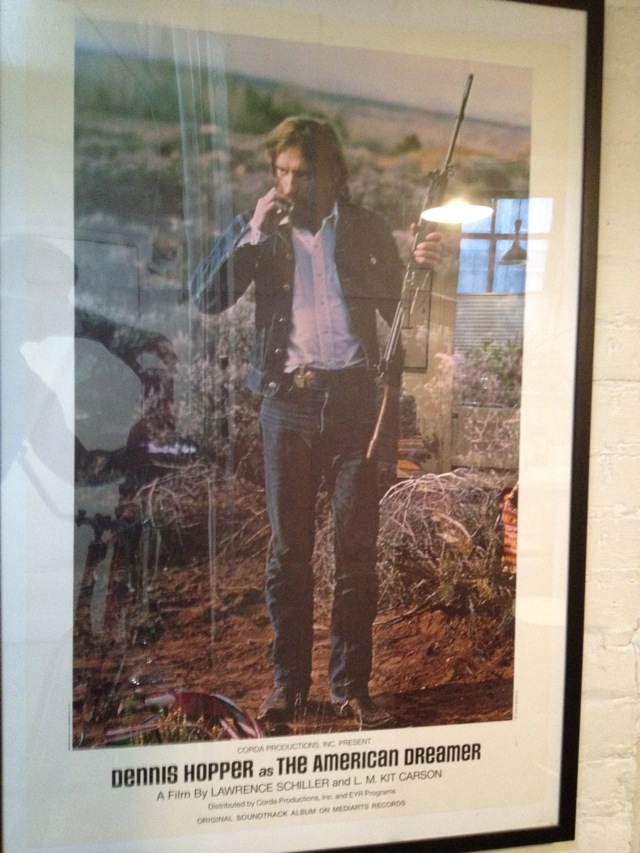
King: Some of the most important films, for me, were by Antonioni — Zabriskie Point and The Passenger — and then The Last Movie, Two-Lane Blacktop, a lot of the early Wim Wenders. And obviously Apocalypse Now.
Wigon: It’s interesting, Two-Lane Blacktop stars three musicians.
King: That’s true. Kelly [Reichardt] should probably remake that movie. She’s probably the only one who could pull it off. Anyway, Hopper was kind of a jackass, but he said and did lot of brilliant stuff every once in a while. That film [The American Dreamer] is a pretty amazing documentary about Hopper when he was editing The Last Movie, at the peak of his ego and eccentricity. It’s a beautiful mess, The Last Movie. A true favorite. I love that film.
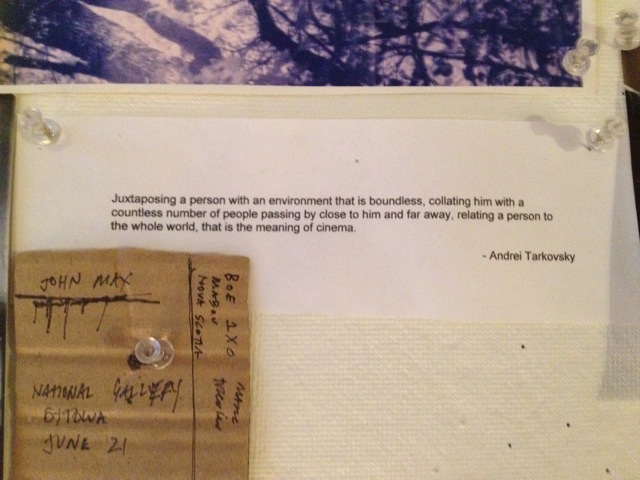
King: I came across this, and I sort of felt like this was what I was trying to do with Here. All this long-winded shit that I’m saying about music and whatnot, Tarkovsky managed to distill all that into one sentence. Film is about something other than the conveyance of information and narrative. Narrative and drama are effective ways of producing emotions in people, but there are other ways of doing it in cinema, and this quote is a really poetic description of the possibilities of the medium.
Wigon: It seems like there’s a sense of composition to the bulletin board.
King: I haven’t been on Pinterest yet, but that’s what it is, right? It’s a bulletin board that you can arrange on the Internet. People doing stuff like this bulletin board is like that, or Tumblr – the analog bulletin board seems like a precursor to all that, right?
Wigon: It’s like great ideas come out of a conversation with one another. Making connections between disparate ideas.
King: That idea of putting things up against each other is really important. That’s why things like Tumblr and Pinterest are so popular. Your ideas about what we surround ourselves in, and the fact that this is not virtual, are interesting things to think about.
Wigon: Well yeah, you keep referring to Tumblr, but the thing is, your bulletin board and office walls are static. Whereas Tumblr is constantly adding new stuff and changing and the older stuff gets lost quickly. Your office is a static map of ideas that can be dwelled on at length.
King: It’s a kind of daydreaming, too. I’m looking at the postcards of these paintings – when I was touring the festivals with HERE, I would always try to drop in on museums. It’s funny how something can sit on your wall for years almost passively and yet somehow get so deeply embedded in your psyche.
